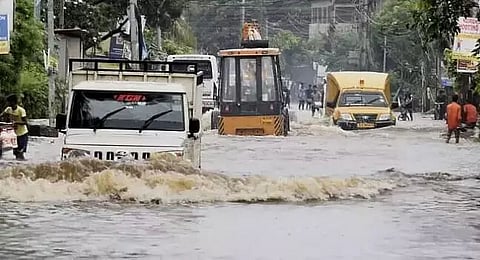
- Home
- Live Blog
- Breaking News
- Top Headlines
- Cities
- NE News
- Sentinel Media
- Sports
- Education
- Jobs

Staff Reporter
GUWAHATI: The ‘Mission flood-free Guwahati’ of the GMC (Guwahati Municipal Corporation) has been going on in a laidback attitude, to be precise, in the proverbial lahe lahe pace in our Assamese social life. A few questions that strike every right-thinking person are: Will the mission really come to fruition? Will the civic body walk the talk? Is GMC working in the right direction?
Since March this year, the civic body has been cleaning and de-silting drains, and this drive will continue till October.
The GMC has the responsibility of cleaning 294 drains and five rivulets in Guwahati. The rivulets are: Bahini, Bharalu, Morabharalu, Basistha, and Lakhimijan. The PWD, on the other hand, has the onus of cleaning 158 drains in the metropolitan city.
The civic body has put into service ten super sucker vehicles for cleaning big drains, besides engaging workers to do the job manually. This activity of the civic body seems to have been a routine affair for years and years. One can gauge the outcome of such activities during the monsoon with ease. What is glaringly visible in Guwahati is that a smart spell of rain continuing for half an hour is enough to make Guwahatians wade through knee-deep (waist-deep in some places, like Anil Nagar) water. The artificial flood in Guwahati that claimed many lives in the past needs no mention, at least for the people of this metropolitan city.
Taking the gravity of the situation into account, a division bench of the Gauhati High Court on June 3, 2024, had to ask the state government to give details of the steps it has taken to arrest the problem of waterlogging within ten days (PIL No. 14/2024).
It seems that the solution to the problem continues to elude Guwahatians, who have to bear the brunt of waterlogging for years and on.
A common practice seen is that the workers engaged in de-silting and cleaning the choked drains in Guwahati use to keep the silt on the roadside, at least for two days. When asked, Guwahati Mayor Mrigen Sarania said, “The workers keep the silt on the roadside for two days to let water ooze out. After two days, the workers dump the silt at Beltola in the Pamohi area near Deepor Beel.”
However, what is seen on the ground is that in many areas in Guwahati, silt and debris taken out of roadside drains lie unattended on the roadside for weeks, posing a threat of health hazards.
Speaking to this reporter, Dwipen Deka of the Bhangagrh area in Guwahati said, “GMC workers clean the drains every year, and sometimes they leave debris and silt on roadsides for weeks. When it gets dried, a portion of the debris flies away along with running vehicles. When the debris gets wet due to rain again, it goes back to the drains. This is a continuous process that sees no meaningful end.”
Thus, the question, ‘Is GMC working in the right direction?’ continues to stare at the civic body, seeking the right response.
If the civic body scrupulously wants to make Guwahati free from waterlogging, it should come forward with concrete and scientific plans, if need be, with proper and genuine consultancy services.
Also Watch: